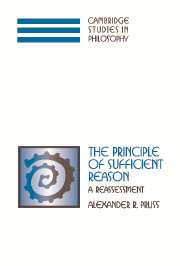Book contents
- Frontmatter
- Contents
- Acknowledgments
- Part I The Principle of Sufficient Reason and the Causal Principle
- Part II Objections to the PSR
- 4 A Modern Version of the Hume Objection
- 5 The Anti-theological Argument That There Are No Necessary Beings
- 6 Modal Fatalism
- 7 Free Will
- 8 Quantum Mechanics
- 9 Turning Leibniz against the PSR
- 10 What Survives the Criticisms of the PSR?
- Part III Justifications of the PSR
- Bibliography
- Index
9 - Turning Leibniz against the PSR
Published online by Cambridge University Press: 27 July 2009
- Frontmatter
- Contents
- Acknowledgments
- Part I The Principle of Sufficient Reason and the Causal Principle
- Part II Objections to the PSR
- 4 A Modern Version of the Hume Objection
- 5 The Anti-theological Argument That There Are No Necessary Beings
- 6 Modal Fatalism
- 7 Free Will
- 8 Quantum Mechanics
- 9 Turning Leibniz against the PSR
- 10 What Survives the Criticisms of the PSR?
- Part III Justifications of the PSR
- Bibliography
- Index
Summary
Recall Leibniz's argument that the PSR entails that space and time cannot be absolute, since otherwise it makes sense to ask, but by the nature of the matter it is impossible to answer, why the universe is situated in space and time where it is, rather than all moved over spatiotemporally. This can be turned around into a reductio ad absurdum of the PSR: space and time are absolute; hence the PSR is false.
The general structure of the argument is this.
(86) There is a possible world w* just like the actual world in all qualitative features but nonetheless differing from the actual world in terms of the numerical identity of some entity (an object, a place, a time, etc.).
(87) If two worlds w and w* have the same qualitative features, then no explanation can be given for why one rather than the other is actual.
(88) Therefore, the PSR can be false; that is, there can be a contingent proposition p with no explanation.
It is plain that the argument is valid: just let p be the proposition that w rather than w* is actual. The only question, again, is as to soundness.
IN FAVOR OF (86)
Premise (86) asserts the existence of a world qualitatively identical to the actual one yet somehow different. There are several ways of substantiating (86). One way is via a spatiotemporal translation as in Leibniz: just imagine all the contents of space-time having been moved over. Another is through considerations of counterfactuals.
- Type
- Chapter
- Information
- The Principle of Sufficient ReasonA Reassessment, pp. 171 - 183Publisher: Cambridge University PressPrint publication year: 2006



